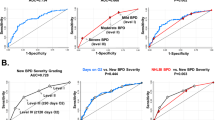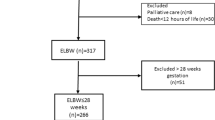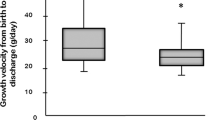Abstract
Objective:
To estimate the risk of death or tracheostomy placement (D/T) in infants with severe bronchopulmonary dysplasia (sBPD) born <32 weeks' gestation referred to regional neonatal intensive care units.
Study Design:
We conducted a retrospective cohort study in infants born <32 weeks’ gestation with sBPD in 2010–2011, using the Children's Hospital Neonatal Database. sBPD was defined as the need for FiO2 ⩾0.3, nasal cannula support >2 l min−1 or positive pressure at 36 weeks' post menstrual age. The primary outcome was D/T before discharge. Predictors associated with D/T in bivariable analyses (P<0.2) were used to develop a multivariable logistic regression equation using 80% of the cohort. This equation was validated in the remaining 20% of infants.
Result:
Of 793 eligible patients, the mean gestational age was 26 weeks' and the median age at referral was 6.4 weeks. D/T occurred in 20% of infants. Multivariable analysis showed that later gestational age at birth, later age at referral along with pulmonary management as the primary reason for referal, mechanical ventilation at the time of referral, clinically diagnosed pulmonary hypertension, systemic corticosteroids after referral and occurrence of a bloodstream infection after referral were each associated with D/T. The model performed well with validation (area under curve 0.86, goodness-of-fit χ2, P=0.66).
Conclusion:
Seven clinical variables predicted D/T in this large, contemporary cohort with sBPD. These results can be used to inform clinicians who counsel families of affected infants and to assist in the design of future prospective trials.
This is a preview of subscription content, access via your institution
Access options
Subscribe to this journal
Receive 12 print issues and online access
$259.00 per year
only $21.58 per issue
Buy this article
- Purchase on Springer Link
- Instant access to full article PDF
Prices may be subject to local taxes which are calculated during checkout

Similar content being viewed by others
References
Jobe AH . The new bronchopulmonary dysplasia. Curr Opin Pediatr 2011; 23: 167–172.
Walsh MC, Szefler S, Davis J, Allen M, Van Marter L, Abman S et al. Summary proceedings from the bronchopulmonary dysplasia group. Pediatrics 2006; 117: S52–S56.
Ehrenkranz RA, Walsh MC, Vohr BR, Jobe AH, Wright LL, Fanaroff AA et al. Validation of the National Institutes of Health consensus definition of bronchopulmonary dysplasia. Pediatrics 2005; 116: 1353–1360.
Natarajan G, Pappas A, Shankaran S, Kendrick DE, Das A, Higgins RD et al. Outcomes of extremely low birth weight infants with bronchopulmonary dysplasia: Impact of the physiologic definition. Early Hum Dev 2012; 88: 509–515.
Lagatta J, Clark R, Spitzer A . Clinical predictors and institutional variation in home oxygen use in preterm infants. J Pediatr 2012; 160: 232–238.
Van Marter LJ . Epidemiology of bronchopulmonary dysplasia. Semin Fetal Neonatal Med 2009; 14: 358–366.
Mandy G, Malkar M, Welty SE, Brown R, Shepherd E, Gardner W et al. Tracheostomy placement in infants with bronchopulmonary dysplasia: safety and outcomes. Pediatr Pulmonol 2013; 48: 245–249.
American Academy of Pediatrics Committee on Fetus & Newborn. Levels of neonatal care. Pediatrics 2012; 130 (3): 587–589.
Murthy K, Dykes FD, Padula MA, Pallotto EK, Reber KM, Durand DJ et al. The Children’s Hospitals Neonatal Database: an overview of patient complexity, outcomes and variation in care. J Perinatol 2014. (accepted for publication, in press).
Stark AR . American Academy of Pediatrics Committee on Fetus & Newborn Levels of neonatal care. Pediatrics 2004; 114 (5): 1341–1347.
Walsh MC, Yao Q, Gettner P, Hale E, Collins M, Hensman A et al. Impact of a physiologic definition on bronchopulmonary dysplasia rates. Pediatrics 2004; 114 (5): 1305–1311.
Olsen IE, Groveman SA, Lawson ML, Clark RH, Zemel BS . New intrauterine growth curves based on United States data. Pediatrics 2010; 125: e214–e224.
Bhat R, Salas A, Foster C, Carlo WA, Ambalavanan N . Prospective analysis of pulmonary hypertension in extremely low birth weight infants. Pediatrics 2012; 129: e682–e689.
Stoll BJ, Hansen NI, Bell EF, Shankaran S, Laptook AR, Walsh MC et al. Neonatal outcomes of extremely preterm infants from the NICHD Neonatal Research Network. Pediatrics 2012; 126: 443–456.
Horan TC, Andrus M, Dudeck MA . CDC/NHSN surveillance definition of health care-associated infection and criteria for specific types of infections in the acute care setting. Am J Infect Control 2008; 36: 24–24.
Tyson JE, Parikh NA, Langer JJ, Green CC, Higgins RD . Intensive care for extreme prematurity—moving beyond gestational age. N Engl J Med 2008; 358: 1672–1681.
Stoll BJ, Hansen NI, Adams-Chapman I, Fanaroff AA, Hintz SR, Vohr B et al. Neurodevelopmental and growth impairment among extremely low-birth-weight infants with neonatal infection. JAMA 2004; 292 (19): 2357–2365.
Schlapbach LJ, Aebischer M, Adams M, Natalucci G, Bonhoeffer J, Latzin P et al. Impact of sepsis on neurodevelopmental outcome in a Swiss National Cohort of extremely premature infants. Pediatrics 2011; 128 (2): e348–e357.
Been JV, Rours IG, Kornelisse RF, Jonkers F, de Krijger RR, Zimmermann LJ . Chorioamnionitis alters the response to surfactant in preterm infants. J Pediatr 2010; 156 (1): 10–11.
Vento M, Moro M, Escrig R, Arruza L, Villar G . Preterm resuscitation with low oxygen causes less oxidative stress, inflammation, and chronic lung disease. Pediatrics 2009; 124 (3): e439–e449.
Check J, Gotteiner N, Liu X, Su E, Porta NFM, Steinhorn RH et al. Fetal growth restriction and pulmonary hypertension in premature infants with bronchopulmonary dysplasia. J Perinatol 2013; 33 (7): 553–557.
Doyle LW, Halliday HL, Ehrenkranz RA, Davis PG, Sinclair JC . Impact of postnatal systemic corticosteroids on mortality and cerebral palsy in preterm infants: effect modification by risk for chronic lung disease. Pediatrics 2005; 115 (3): 655–661.
Halliday HL, Ehrenkranz RA, Doyle LW . Early (< 8 days) postnatal corticosteroids for preventing chronic lung disease in preterm infants. Cochrane Database Syst Rev 2010; (doi:10.1002/14651858.CD001146.pub 3)
Payne NR, Barry J, Berg W, Brasel DE, Hagen EA, Matthews D et al Sustained reduction in neonatal nosocomial infections through quality improvement efforts. Pediatrics 2012; 129 (1): e165–e173.
Vohr BR, Wright LL, Dusick AM, Perritt R, Poole WK, Tyson JE et al. Center differences and outcomes of extremely low birth weight infants. Pediatrics 2004; 113 (4): 781–789.
Nowadzky T, Pantoja A, Britton JR . Bubble continuous positive airway pressure, a potentially better practice, reduces the use of mechanical ventilation among very low birth weight infants with respiratory distress syndrome. Pediatrics 2009; 123 (6): 1534–1540.
Birenbaum HJ, Dentry A, Cirelli J, Helou S, Pane MA, Starr K et al. Reduction in the incidence of chronic lung disease in very low birth weight infants: results of a quality improvement process in a tertiary level neonatal intensive care unit. Pediatrics 2009; 123 (1): 44–50.
Acknowledgements
JMA, DJD, FDD, JRE (Chair), KM, MAP, EKP, KMR and BLS are members of the Children’s Hospital Neonatal Consortium, Inc. The CHNC (http://www.thechnc.org) has partnered with Children’s Hospital Association, Inc. (Overland Park, KS, USA) to design, launch and maintain the CHND. We are indebted to the following institutions that serve the infants and their families, and these institutions also have invested in and continue to participate in the Children’s Hospital’s Neonatal Database (CHND). For more information please contact Kate Conrad (chnd@childrenshospitals.org). The site sponsors for the CHND are also included:
1 Children's Healthcare of Atlanta, Atlanta, GA (Francine Dykes, Anthony Piazza)
2 Children’s Healthcare of Atlanta at Scottish Rite (Gregory Sysyn)
3 Children's Hospital of Alabama, Birmingham, AL (Carl Coghill)
4 Le Bonheur Children's Hospital, Memphis, TN (Ramasubbareddy Dhanireddy)
5 Children's Hospital Boston, Boston, MA (Anne Hansen)
6 Ann & Robert H. Lurie Children’s Hospital of Chicago, Chicago, IL (Karna Murthy)
7 Nationwide Children's Hospital, Columbus, OH (Kristina Reber)
8 Children's Medical Center, Dallas, TX (Rashmin Savani, Luc Brion)
9 Children's Hospital Colorado, Aurora, CO (Theresa Grover)
10 Children’s Hospital of Michigan, Detroit, MI (Girija Natarajan)
11 Cook Children's Health Care System, Fort Worth, TX (Jonathan Nedrelow, Annie Chi)
12 Texas Children's Hospital, Houston, TX (Yvette Johnson)
13 Children's Mercy Hospitals & Clinics, Kansas City, MO (Eugenia Pallotto)
14 Arkansas Children's Hospital, Little Rock, AR (Becky Rodgers)
15 Children’s Hospital Los Angeles, Los Angeles, CA (Lisa Kelly*, Steven Chin)
16 Children's Hospital & Research Center Oakland, Oakland, CA (David Durand, Jeanette Asselin)
17 The Children's Hospital of Philadelphia, Philadelphia, PA (Jacquelyn Evans, Michael Padula)
18 Children's Hospital of Pittsburgh of UPMC, Pittsburgh, PA (Beverly Brozanski)
19 St Louis Children's Hospital, St Louis, MO (Joan Rosenbaum, Tasmin Najaf, Rakesh Rao, Amit Mathur)
20 All Children's Hospital, St. Petersburg, FL (Victor McKay)
21 Rady Children's Hospital, San Diego, CA (Mark Speziale)
22 Children's National Medical Center, Washington, DC (Billie Short)
23 AI DuPont Hospital for Children, Wilmington, DE (Kevin Sullivan)
24 Primary Children’s Medical Center, Salt Lake City, UT (Donald Null)
25 Children’s Hospital of Wisconsin, Milwaukee, WI (Michael Uhing)
26 Children’s Hospital of Omaha (Lynne Willett, John Grebe)
27 Florida Hospital for Children (Rajan Wadhawan)
*deceased
Author information
Authors and Affiliations
Corresponding author
Ethics declarations
Competing interests
A portion of JMA’s salary was provided by Children’s Hospital Association, Inc., for the development and maintenance of the database that was analyzed for this study. Remaining authors have no conflicts of interest relevant to this article to disclose. Also, the Friends of Prentice Foundation, USA (Chicago, IL) sponsored a portion of this work. Dr RCS receives salary support from the William Buchanan Chair in Pediatrics within his affiliated institution. The sponsors had no input in the study design, the collection, analysis and interpretation of data, the writing of the report and the decision to submit the paper for publication.
Additional information
Supplementary Information accompanies the paper on the Journal of Perinatology website
Supplementary information
Rights and permissions
About this article
Cite this article
Murthy, K., Savani, R., Lagatta, J. et al. Predicting death or tracheostomy placement in infants with severe bronchopulmonary dysplasia. J Perinatol 34, 543–548 (2014). https://doi.org/10.1038/jp.2014.35
Received:
Revised:
Accepted:
Published:
Issue Date:
DOI: https://doi.org/10.1038/jp.2014.35
Keywords
This article is cited by
-
Transpyloric feeding is associated with adverse in-hospital outcomes in infants with severe bronchopulmonary dysplasia
Journal of Perinatology (2024)
-
In-hospital mortality and length of hospital stay in infants requiring tracheostomy with bronchopulmonary dysplasia
Journal of Perinatology (2023)
-
Qualitative indications for tracheostomy and chronic mechanical ventilation in patients with severe bronchopulmonary dysplasia
Journal of Perinatology (2021)
-
Utility of echocardiography in predicting mortality in infants with severe bronchopulmonary dysplasia
Journal of Perinatology (2020)
-
Medication use in infants with severe bronchopulmonary dysplasia admitted to United States children’s hospitals
Journal of Perinatology (2019)



